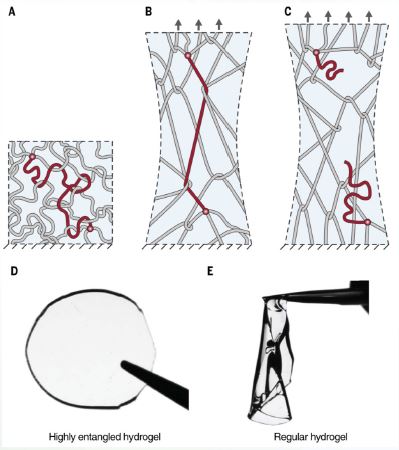Fracture, Fatigue, and Friction of Polymers
in which entanglements greatly outnumber cross-links

Hydrogels and elastomers have similar mechanical properties as living tissues. Hence, they are being widely developed for biomedical applications. However, to date, it has not been possible to simultaneously enhance both their stiffness and toughness, as these are orthogonal properties. Existing toughening mechanisms also lead to large hysteresis, which is undesirable for materials subjected to cyclic loads.
A research team from the Harvard MRSEC, led by Zhigang Suo, has designed a new class of polymers, in which physical entanglements between polymer chains greatly outnumber their chemical crosslinks. Under mechanical load, tensile stress experienced by a given chain is transmitted to surrounding entangled chains, which are prevented from disentangling due to sparsely distributed crosslinks that connect them. These engineered polymers exhibit high toughness, strength, and fatigue resistance. Upon swelling in water, the resulting hydrogels display low hysteresis, low friction, and high wear resistance.
Article:
Elastic polymer that is both stiff and tough, resolves long-standing quandary
Publication:
Junsoo Kim, Guogao Zhang, Meixuanzi Shi, Zhigang Suo, "Fracture, fatigue, and friction of polymers in which entanglements greatly outnumber cross-links," Science, 374(6564), 212-216 (2021) ![]()
![]()
Zhigang Suo (Material Science & Mechanical Engineering)
2021-2022 Harvard MRSEC (DMR-2011754)
